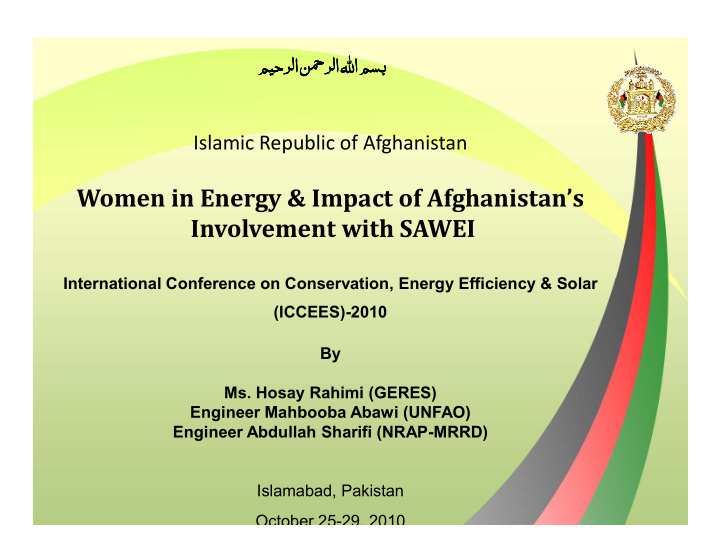



ﻢﻴﺣﺮﻟا�ﻦﲪﺮﻟا�ﷲا�ﻢﺴﺑﻢﻴﺣﺮﻟا�ﻦﲪﺮﻟا�ﷲا�ﻢﺴﺑﻢﻴﺣﺮﻟا�ﻦﲪﺮﻟا�ﷲا�ﻢﺴﺑﻢﻴﺣﺮﻟا�ﻦﲪﺮﻟا�ﷲا�ﻢﺴﺑ Islamic Republic of Afghanistan Women in Energy & Impact of Afghanistan’s Involvement with SAWEI �������������������������������������������������������������������� �������������������������������������������������������������������� ������������� �� ���������� �!�"���#� ��� �����������!$��$��%$�&���'()%*� ���������%$+,���!��!�������( %-�� .� ������������������� �������������������
General Information Capital Kabul Total Population 28 Millions 49% F, 51% M Growth Rate Growth Rate 2.69 % 2.69 % Rural Population 75% Area 647,700 square Km Official Languages Pashto and Dari Provinces 34
Energy Situation of Afghanistan � 15.6% from public utility Access to electricity in urban area � 9.2% from private sources � 4.3% from public sources Rural electrification � 9.8% from private sources � 9.8% from private sources Afghanistan National Development Strategy (ANDS) Energy Benchmark By end of 2010 electricity will reach at least: � 65% of HHs in urban areas � 90% of non-residential establishments in major urban areas � 25% of households in rural areas
Power Capacity of Afghanistan (MW)
Potential Areas for RE Projects � Herat Province is known for its 120 days of very strong winds. Even during the remaining part of the year, good winds are available therefore it has been identified for wind demonstration site. � Kabul, Nangarhar, Laghman, Heart and Logar Provinces has been identified for biogas demonstration as it has favorable temperature for biogas generation and the villagers have sufficient numbers of animals. More than 100 units have already been constructed in the target area. � ICS will be demonstrated in all pilot project areas
Women in Renewable Energy in Afghanistan By Eng. Mahbooba Abawi Community Development and Gender Officer UNFAO-Kabul abawi_mahbooba@yahoo.com
Rural Population and Renewable Energy � Due to the isolated nature of the rural population, renewable energy offers the best solution for electrification for the majority of Afghanistan’s rural population that currently does not have access to electricity and has no real expectation of connection to the grid. � Most of Afghans have no access to modern forms of energy. � Fuel wood accounts for an estimated 75% of total rural energy supplies which have adverse impact on forests.
Rural Population and Renewable Energy � Burning these fuels increases indoor air pollution, which adversely affects the health of women and children in particular. � Extreme poverty in rural areas also is related to lack of income earning opportunities. � The productive use of electricity helps reduce poverty by providing alternative sources of livelihoods and increase educational and training opportunities.
Energy Involved Organizations in Afghanistan 1. Government � MoEW Mini and small hydropower projects � NSP-MRRD Micro-hydropower & solar PV at CDC level through IPs (UN-Habitat, AKDN, CONCERN, DACAAR, MADERA, GAA, ACTED, CARE, BRAC, and Afghan CONCERN, DACAAR, MADERA, GAA, ACTED, CARE, BRAC, and Afghan Aid 2. UN Agencies and International NGOs � USAID/ACEP Power generation, energy efficiency, renewable energy integration Capacity building and policy support/ SRAI/E solar and wind � UNFAO Supports MAIL in central and rural area
Energy Involved Organizations in Afghanistan � UNDP Supports MRRD for ERDA-NABDP � GTZ Technical support to MoEW Support to private companies Support to private companies � JICA Construction of 5 micro-hydropower projects. � Korea Funded the Istalif Mini Hydropower project (300 kW). � World Bank Support energy projects through the NSP
Energy Involved Organizations in Afghanistan � ADB Constructed the Bande-Amir (9 kW) micro-hydropower project. Preparing a project to construct 5 MW of mini hydro in 4 mountain provinces � Norwegian Church Aid Invested in 5 villages � GERES (Group for Environment Renewable Energy & Solidarity) � GERES (Group for Environment Renewable Energy & Solidarity) French NGO, working energy efficiency in public buildings such as thermal insulation & double glassing) 3. Private Companies/ Association � Sesa � Tole Shams � AWEA
Challenges and Constraints � Lack of a clear national policy of RE. � Weak technological base and low capacity in the country. � Weak coordination among stakeholders. � Weak donor coordination on rural energy investments.
Light in Women Life Organization (LWL) ���������������������������� $������"�/����!��������0 � �+,������ � �+,������ � �����!���������������� � �"1���"���� #������������"�����!�11�� ��"������+�!����!���������
Light in Women Life Organization (LWL) The Mission Benefiting the rural population specially the rural women through clean, sustainable and renewable energy. The Mission Statement The Mission Statement To ensure the social, economic and environmental well- being of the rural communities, specially poor and vulnerable people, through the provision of basic access to sustainable and clean energy. Overall Goal To enhance green environment, healthy society and promote equitable growth through access to renewable and clean energy in rural Afghanistan
An Initiative of the USAID Afghanistan Clean Energy Program (ACEP)
How AWEA Started � SARI/Energy-USAID organized serial of workshops in India, Bangladesh , Washington D.C- USA and Pakistan on Women in Energy (SAWIE). � Afghan Women have been participating the workshops � Afghan Women have been participating the workshops since 2008. � USAID/ACEP assisted Afghan Women to establish AWEA. � AWEA has organized its first meeting on October 7 th , 2010.
How AWEA Started � Beside SAWIE trained participants, several interested Afghan women attended the meeting.
Objective: • To encourage more participation of Afghan Women in Energy • Creating a network of communication between Afghan Women. AWEA’S Proposed Activities • To raise awareness • Capacity Building (ToT, Community based trainings on energy efficiency, saving energy and other related topics). • Women should be trained for the operation and maintenance of energy equipments
����������������� ����!!��� ����!�"�������
AWEA Members � Engineers, professors, program managers, a medical doctor, a finance manager, and politicians. � Current Involved Organizations: SESA, Flag International, CBFA, HZA, Tole Shams, ICC, MRRD, Ministry of Women, UNFAO, GERES and Kabul MRRD, Ministry of Women, UNFAO, GERES and Kabul University. � Technical assistance of SARI/Energy India.
Where is AWEA right now? � Formalization of the Association � Elections of board of directors � Preparing Plan of Work � Development By Laws � Development By Laws
�"����.��1����2���*�����333 Reference person for more information Dr. Alma Cota the Capacity Building Coordinator at ACEP acota@winrockafghanistan.org acota@winrockafghanistan.org Hosay Rahimi Communication Manager at GERES h.rahimi@geres.eu
Thank You Thank You
Recommend
More recommend